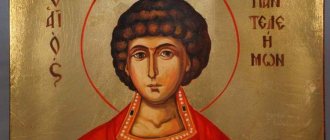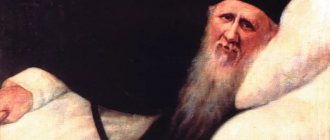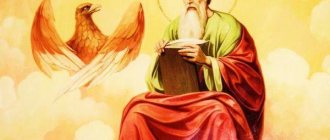Akathist to the Holy Great Martyr and Healer Panteleimon
Life of the Great Martyr and Healer Panteleimon
The holy great martyr and healer Panteleimon was born in Bithynia (Asia Minor) in the city of Nicomedia into the family of a noble pagan Eustorgius and was named Pantoleon (which means “a lion throughout”), since his parents wanted to see him as a courageous and fearless young man.
His mother, Saint Evvula (March 30), raised the boy in the Christian faith, but ended her earthly life early. Then his father sent Pantoleon to a pagan school, and then taught him the art of medicine from the famous doctor Euphrosynus in Nicomedia. Distinguished by his eloquence, good behavior and extraordinary beauty, young Pantoleon was presented to Emperor Maximian (284–305), who wanted to keep him as a court physician. At this time, the Hieromartyrs Presbyters Hermolai, Hermippus and Hermocrates lived secretly in Nicomedia, having survived the burning of 20 thousand Christians (December 28) in the Nicomedia Church in 303 and the suffering of the Hieromartyr Anthimus (September 3). From the window of a secluded house, Saint Hermolai repeatedly saw a handsome young man and shrewdly saw in him the chosen vessel of God's grace. One day the presbyter called Pantoleon to his place and began a conversation with him, during which he explained to him the basic truths of the Christian faith. From then on, Pantoleon began to visit the Hieromartyr Ermolai every day and listened with pleasure to what God’s servant revealed to him about the Sweetest Jesus Christ.
One day, returning from the teacher, the young man saw a dead child lying on the road, bitten by an echidna, which was wiggling right next to him. Filled with compassion and pity, Pantoleon began to ask the Lord to resurrect the deceased and kill the poisonous reptile. He firmly decided that if his prayer was fulfilled, he would become a Christian and receive Holy Baptism. And by the action of Divine grace the child came to life, and the echidna scattered into pieces before the eyes of the surprised Pantoleon.
After this miracle, Saint Hermolai baptized the young man in the name of the Father and the Son and the Holy Spirit. The newly baptized man spent seven days with his spirit-bearing teacher, absorbing the divinely revealed truths of the Holy Gospel into his heart. Having become a Christian, Pantoleon often talked with his father, revealing to him the falsity of paganism and gradually preparing him to accept Christianity. At this time, Pantoleon was already known as a good doctor, so they brought to him a blind man whom no one else could heal. “The Father of Light will return light to your eyes. True God,” the saint said to him, “in the name of my Lord Jesus Christ, who enlightens the blind, receive your sight!” The blind man immediately received his sight, and along with him, the saint’s father, Eustorgius, also received his spiritual sight, and both joyfully accepted Holy Baptism.
After the death of his father, Saint Pantoleon dedicated his life to the suffering, sick, poor and poor. He treated everyone who turned to him free of charge, visited prisoners in prisons and at the same time healed the suffering not so much with medical means, but by invoking the Lord Jesus Christ. This caused envy, and the doctors reported to the emperor that Saint Pantoleon was a Christian and was treating Christian prisoners.
Maximian persuaded the saint to refute the denunciation and make a sacrifice to idols, but the chosen passion-bearer of Christ and the gracious physician confessed himself to be a Christian and, in front of the emperor’s eyes, healed the paralytic: “In the name of the Lord Jesus Christ, arise and be healthy,” said Saint Pantoleon, and the sick man immediately recovered. The embittered Maximian ordered the execution of the healed man, and betrayed Saint Pantoleon to the cruellest tortures. “Lord Jesus Christ! Appear to me at this moment, give me patience so that I can endure the torment to the end!” - the saint prayed and heard a voice: “Do not be afraid, I am with you.” The Lord appeared to him “in the form of presbyter Ermolai” and strengthened him before suffering. The Great Martyr Pantoleon was hanged from a tree and his body was torn with iron hooks, burned with candles, stretched on a wheel, thrown into boiling tin, and thrown into the sea with a stone around his neck. However, in all the tortures, the courageous Pantoleon remained unharmed and boldly denounced the emperor. The Lord repeatedly appeared to the saint and strengthened him. At the same time, presbyters Ermolai, Ermippus and Hermocrates appeared before the court of the pagans. They courageously confessed the Sweetest Lord Jesus and were beheaded (July 26).
By order of the emperor, the holy great martyr Pantoleon was brought to the circus and thrown to be torn to pieces by wild animals. But the animals licked his feet and pushed each other away, trying to touch the saint’s hand. Seeing this, the spectators rose from their seats and began shouting: “Great is the Christian God! May the innocent and righteous young man be released!” The enraged Maximian ordered the soldiers to kill with swords all who glorified the Lord Jesus, and even kill the animals that did not touch the holy martyr. Seeing this, Saint Pantoleon exclaimed: “Glory to Thee, Christ God, that not only people, but also animals die for You!”
Finally, maddened with rage, Maximian ordered the head of the Great Martyr Pantoleon to be cut off. The soldiers brought the saint to the place of execution and tied him to an olive tree. When the great martyr began to pray to the Lord, one of the soldiers hit him with a sword, but the sword became soft as wax and did not cause any wound. Amazed by the miracle, the soldiers shouted: “Great is the Christian God!” At this time, the Lord once again revealed himself to the saint, calling him Panteleimon (which means “much merciful”) instead of his previous name Pantoleon, for his great mercy and compassion. Hearing the Voice from Heaven, the soldiers fell to their knees before the martyr and asked for forgiveness. The executioners refused to continue the execution, but the Great Martyr Panteleimon ordered the emperor’s order to be carried out. Then the soldiers said goodbye to the great martyr with tears, kissing his hand. When the martyr's head was cut off, milk flowed out of the wound along with blood, and the olive tree to which the saint was tied, at that moment blossomed and was filled with healing fruits. Seeing this, many people believed in Christ Jesus. The body of Saint Panteleimon, thrown into the fire, remained undamaged, and then the Nicomedia passion-bearer was buried by Christians on the nearby land of the scholastic Adamantium.
Lawrence, Vassa and Provian, servants of the great martyr, wrote a narrative about the life, suffering and death of the great martyr. The memory of Saint Panteleimon has been revered by the Orthodox East since ancient times. Already in the 4th century, churches were erected in the name of the saint in Armenian Sebastia and Constantinople. The blood and milk that flowed during the beheading of the saint were kept until the 10th century and were given healing to believers.
The venerable relics of the Great Martyr Panteleimon were scattered in pieces throughout the Christian world. There are especially many of them on Holy Mount Athos. His honest and multi-healing head is kept in the Russian Athos Monastery of St. Panteleimon, in the cathedral church dedicated to his name.
In Nicomedia, on the eve of July 27 - the day of remembrance of the holy great martyr - a solemn religious procession is held with the miraculous icon of the saint. Thousands of people - Orthodox Christians and non-Orthodox - Armenians, Catholics, and even Mohammedans come here and bring hundreds of sick people who receive healing through the prayers of the saint. The church book “Kondak,” kept in the Nicomedia Metropolis, records two thousand autographs of Greeks, Turks, Italians and Armenians who received healing through the prayers of the Great Martyr Panteleimon.
The veneration of the holy martyr in the Russian Orthodox Church has been known since the 12th century. Grand Duke Izyaslav, in Holy Baptism Panteleimon, had the image of the great martyr on his battle helmet and through his intercession he remained alive in the battle of 1151. Under the command of Peter I, Russian troops won two naval victories over the Swedes on the day of remembrance of the Great Martyr Panteleimon: in 1714 at Gangauze (Finland) and in 1720 at Grengam (a small harbor on the Åland Islands).
The name of the Holy Great Martyr Panteleimon is invoked when performing the Sacrament of Anointing, blessing of water and prayer for the weak. His memory is especially solemnly celebrated in the Russian St. Panteleimon Monastery on Athos. The cathedral in his name was built in 1826 according to the type of ancient Athos temples. In the altar, in a precious ark, the main shrine of the monastery is kept - the head of the holy great martyr Panteleimon. 8 days before the holiday, the forefeast begins. On these days, after Vespers, prayer canons are sung in 8 voices; it is noteworthy that for each day there is a special canon. On the day of the holiday, a solemn all-night vigil is held and thousands of guests and pilgrims participate in the divine service. Based on the handwritten Athos service, the choruses on the 9th song of the canon to the Great Martyr are printed. According to ancient tradition, pilgrims of the Russian Orthodox Church annually travel to Greece and to Holy Mount Athos on the day of remembrance of the Holy Great Martyr Panteleimon.
See also: “ The Suffering of the Holy Great Martyr Panteleimon” as presented Demetrius of Rostov.
What is an akathist?
The akathist to the healer Panteleimon, like any akathist, is a special chant of praise and gratitude. Initially, the akathists were dedicated to the Most Holy Theotokos, but later they were written to the Lord, the Angelic powers and the saints. The first akathist appeared in the 6th century, but these songs of praise have been compiled in the Church to this day. The authors of akathists, especially ancient ones, often remain unknown.
Akathist to the great martyr and healer Panteleimon is one of the most popular among believers. From our article you will learn why so many people turn to Saint Panteleimon, in what cases the akathist is read to him and how the healer answers prayers. But first, we suggest reading the akathist itself.
Icon of the Holy Great Martyr and Healer Panteleimon
Holy healer Panteleimon: what they pray for
In Rus', the Great Martyr Panteleimon is a particularly revered saint. People turn to his help mainly during illnesses. This tradition is connected with the fact that even during his earthly life he became famous as a free healer. Also, through him, God performed many miracles - Panteleimon resurrected the dead, healed the blind and paralyzed, and consoled the suffering. He is an intercessor for people before God. Through his prayers to the Lord, believers receive healing from certain diseases. Doctors, considering him their patron, turn to him for help in medicine.
What does an akathist consist of?
Each akathist has the following structure: 12 ikos and 13 kontakia, which alternate with each other. The Ikos ends with the words of Hayretism (greeting) “Rejoice,” and the Kontakion ends with “Hallelujah.” The ikos contains 12 hayretisms, which, after a short introductory part, are its main text.
The word “akathist” itself is translated from Greek as “unsaddled,” that is, it is read while standing, with the exception of weakened people. Not only a clergyman, but every believer can read the akathist.
The miraculous help of Saint Panteleimon after reading the akathist
In 2009, a woman, Veronica, who lived in the city of Cologne (Germany), developed pus under a sore tooth. She had it removed at the dental clinic. However, the next day the woman developed a fever and her cheek became swollen. Surgical intervention was required, the doctor scheduled a visit tomorrow. Then Veronica and her husband began to read an akathist to the holy healer Panteleimon. Before she had time to finish reading it, the woman felt in her mouth the taste of pus, which began to flow out from under the sore tooth. The next day, the doctor confirmed that the pus came out on its own and no surgery was needed.
In 2012, a young student approached the Barnaul priest from the chapel of the martyr Tatiana, Alexander Mikushin. Her sister was in a coma for several days after a car accident. Then the priest began to serve a prayer service with the reading of an akathist to the holy Great Martyr Panteleimon. The next day, the patient began to show signs of life and soon began to recover. And a month and a half later, she and her sister came to the Sacrament of Unction.
Read us conveniently on social networks:
Tags: akathist to the great martyr and healer Panteleimon, akathist to Panteleimon, akathist to Panteleimon the healer, akathist to Panteleimon the healer about health, akathist to Saint Panteleimon





